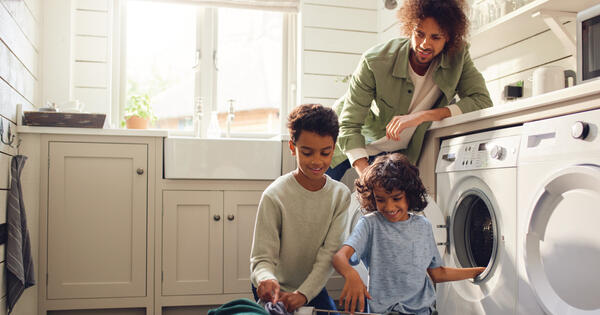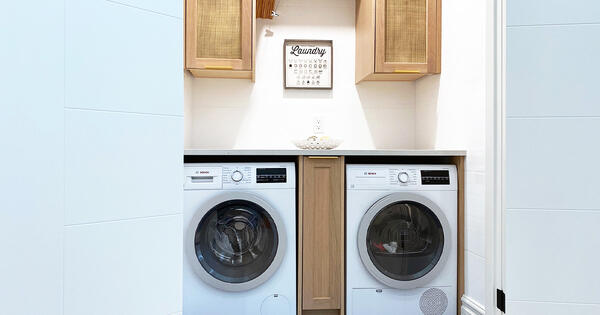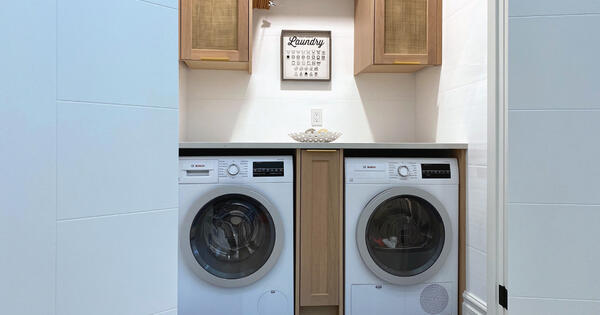Laundry rooms are some of the hardest-working spaces in a home and they often don’t get the attention they deserve when it comes to design or durability. That’s where wainscoting comes in.
Wainscoting in a laundry room is a smart way to blend style with function. Traditionally, wainscoting refers to decorative paneling that covers the lower portion of a wall, originally used to insulate and protect interior surfaces. Today, it’s just as useful, especially in spaces where moisture, spills, and scuffed walls are common. In laundry rooms, wainscoting doesn’t just improve how the space looks — it adds a layer of protection that makes the room easier to clean and more resilient to everyday wear and tear.
Whether you're dealing with water splashes from a utility sink or dents from laundry baskets being shoved against the wall, wainscoting offers a solution that holds up and looks good doing it.
Benefits of Wainscoting in a Laundry Room
Laundry rooms see their fair share of water, humidity, and frequent contact — all of which can take a toll on painted drywall. That’s where wainscoting offers some real advantages.
Here are a few of the key ways wainscoting in a laundry room can be both practical and stylish:
- Wall protection: It acts as a buffer between walls and appliances, baskets, or mops — helping to prevent dings, scuffs, and scrapes.
- Moisture resistance: Certain materials like PVC, vinyl, or tile are better equipped to handle the humidity and occasional water splashes that are common in laundry areas.
- Durability: It holds up far better over time than unprotected drywall, especially in high-traffic or utility-heavy spaces.
- Easy maintenance: Smooth, wipeable surfaces make cleaning up detergent splatters or muddy footprints quick and painless.
- Aesthetic upgrade: It gives the room a finished look that feels more intentional — whether you're after a traditional, modern, or farmhouse-style space.
Wainscoting brings a layer of form and function that makes your laundry area not just more attractive, but more capable of handling the messes that come with the territory.


Types of Wainscoting for Laundry Rooms
Choosing the right type of wainscoting in a laundry room comes down to two things: how you want the room to look, and how well the material will hold up to moisture and daily use.
Here are some common types of wainscoting and how they perform in laundry spaces:
- Beadboard: Offers a classic, cottage-style charm that works well in both traditional and transitional homes. Often made from wood or MDF, it looks great painted but isn’t the best for damp rooms unless it’s sealed properly or made from a moisture-resistant material.
- Board and batten: Creates vertical lines and visual interest with its structured, dimensional style. It gives off a farmhouse or craftsman feel and works best when made with water-tolerant materials in laundry areas.
- Shiplap: Brings a rustic or coastal touch with horizontal planks that offer a modern, clean look. Like beadboard, wood versions need proper sealing — but there are PVC options that provide the same aesthetic with better moisture protection.
- PVC or vinyl panels: Ideal for laundry rooms because they’re water-resistant, lightweight, and easy to wipe down. They mimic the look of traditional wood styles without the risk of warping or mold growth.
- Tile wainscoting: Highly durable and completely splash-proof, tile offers a sleek, hygienic solution for laundry rooms that double as mudrooms or include sinks. It's more expensive and labor-intensive to install but pays off in longevity and low maintenance.
If moisture is a major concern in your laundry space, stick with materials like PVC, vinyl, or tile. They’re built for wet environments and will hold up better over time — without sacrificing style.
Choosing the Right Height, Style, and Color for Wainscoting
When you're planning to install wainscoting in a laundry room, the details matter — especially the height, finish, and how it integrates with the rest of your space.
Most wainscoting falls between 36 and 48 inches tall, depending on ceiling height and the layout of the room. In laundry rooms, a height of 42 inches often hits the sweet spot — tall enough to protect the wall behind appliances and utility sinks, but not so high that it overwhelms the space.
To help the room feel clean and cohesive, consider these popular styling tips:
- Stick to soft, neutral colors: White, off-white, or light gray work well in laundry rooms, keeping the space feeling bright and fresh.
- Go bold for contrast: Deep navy, forest green, or even black can give your laundry area a sophisticated edge — especially when paired with lighter upper walls or cabinetry.
- Match the trim or molding: Using the same color and profile as nearby baseboards or window casings creates a polished, built-in look.
- Blend with cabinetry or shelving: Wainscoting that lines up with cabinetry or built-in storage creates a seamless transition and makes the room feel more intentionally designed.
The beauty of wainscoting is that it can adapt to just about any style — from crisp and modern to rustic farmhouse — all while adding texture and visual interest to an otherwise utilitarian room.
DIY vs. Hiring a Pro for Laundry Room Wainscoting
Wainscoting in a laundry room can be a DIY project, but whether you should tackle it yourself depends on your tools, skill level, and the materials you choose.
For those who are handy and detail-oriented, installing traditional wood or MDF wainscoting is fairly straightforward. You’ll need to measure accurately, make precise cuts (especially around outlets and plumbing), and have a solid plan for caulking, sanding, and painting.
But laundry rooms bring a few extra challenges. Here's what to keep in mind:
- Wall obstacles: Outlets, pipes, and appliances can make clean cuts and consistent panel placement tricky.
- Moisture exposure: Wood and MDF require sealing to prevent swelling or damage in humid environments.
- Time and tools: You’ll need a miter saw, nail gun, level, and patience — especially if it’s your first time.
If you're working with water-resistant materials like PVC or tile, or your walls are uneven, hiring a contractor might be the smarter choice. Pros can ensure a tight fit, clean finish, and faster turnaround — which is especially helpful if your laundry space also functions as a high-traffic mudroom or utility area.



Best Alternative to Traditional Wainscoting: Trusscore Wall&CeilingBoard
If you love the idea of wainscoting in your laundry room but want something more durable than wood or MDF, there's a high-performance alternative worth considering: Trusscore Wall&CeilingBoard.
Trusscore is made from 100% PVC, so it won’t absorb moisture, warp, or grow mold. It’s specifically designed for environments where water, detergent, and daily wear are part of the routine. Thanks to its tongue-and-groove system, installation is fast and clean — no sanding, sealing, or painting required.
Here’s how Trusscore Wall&CeilingBoard compares to traditional wainscoting materials:
- Moisture resistance: PVC construction means it won’t swell, rot, or deteriorate in humid spaces.
- Easy installation: Tongue-and-groove panels snap together quickly with screws so there’s no need for glue or finish nails.
- Low maintenance: Smooth surface resists stains and wipes clean with a damp cloth or mild cleaner.
- Bright, reflective finish: The white panels bounce light, helping smaller or windowless laundry rooms feel bigger and more open.
- Customizable storage: Pairs perfectly with Trusscore SlatWall, so you can add hooks, baskets, or shelving wherever you need them.
If you’re looking for an upgrade that looks clean, holds up under pressure, and simplifies your routine, Trusscore delivers on all fronts.
Design Inspiration: Wainscoting Ideas for Laundry Rooms
Wainscoting in a laundry room doesn’t have to be basic. It can be a design feature that brings character, structure, and visual balance to the space. Whether you’re going for cozy and traditional or clean and contemporary, there are plenty of ways to make it your own.
Here are a few design ideas to inspire your laundry room refresh:
- Half-wall wainscoting with contrast above: Pair classic paneling on the bottom with bold paint, patterned wallpaper, or even tile on the upper wall to add personality and depth.
- Full-wall wainscoting behind appliances or sinks: Create a functional backsplash that protects your walls from splashes and dents while giving the area a more built-in, intentional look.
- Combine vertical paneling with shelving: Mix practical storage and decorative interest by installing open shelves or cabinetry above your wainscoting — especially helpful in tight or awkward layouts.
- Use moisture-resistant panels for a sleek finish: Materials like Trusscore Wall&CeilingBoard deliver a clean, modern aesthetic that’s also tough enough for everyday messes.
Some trending styles you’ll see in today’s laundry rooms include white beadboard with natural wood counters, dark-colored board and batten for a dramatic touch, and full-height shiplap in all-white or soft grays for a minimalist vibe. The key is choosing a style that complements the rest of your home while standing up to the unique demands of a laundry space.
If you're looking for a way to give your laundry area a visual upgrade while also making it easier to clean and maintain, wainscoting is absolutely worth considering. It offers that rare combination of form and function — protecting your walls, simplifying upkeep, and elevating the entire space.
Traditional wood or MDF styles bring charm and customization, but they do require sealing and maintenance to keep up with moisture. If you’d rather not worry about warping, mold, or frequent touch-ups, a PVC-based option like Trusscore Wall&CeilingBoard is a smart investment. It installs easily, holds up against water and impact, and brings a bright, polished finish that works with almost any design.
In the end, the best choice comes down to your goals, budget, and how much time you want to spend maintaining your laundry room. Whether you go classic or modern, painted or paneled, durable or decorative, wainscoting can help you turn a purely functional space into one that’s also thoughtfully designed.






